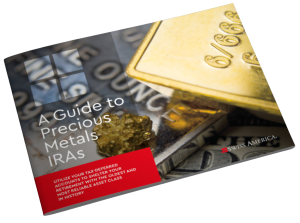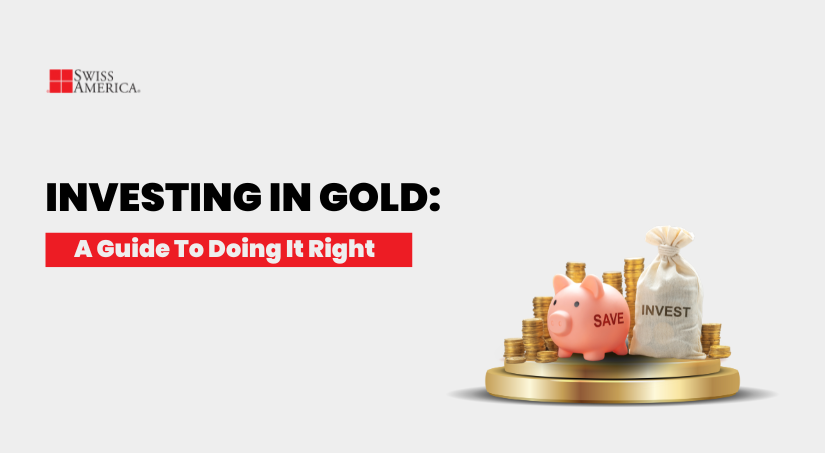
Are you thinking about investing in gold? If you’ve been wondering whether it’s a smart move or if you’ve already missed the boat, this article covers what you need to know to get started.
Gold isn’t some fringe asset. It’s been used for centuries to store value, and it tends to hold up well during times of crisis or economic uncertainty. As Lena Thomas from Goldman Sachs puts it, “Whenever there’s a lot of uncertainty, traders temporarily park their money in gold. When there’s clarity, gold prices tend to drop again because traders know what to do with their money.”
So what are your options? How do you begin? And where can you find information that helps you make sense of the gold market? This article gives you the answers and helps you figure out if gold fits into your long-term strategy.
Types of gold investments
There are a few different ways to invest in gold. You can buy the physical metal itself or invest through paper assets like ETFs or mining stocks.
Investing in physical gold
Here are all the ways to own physical gold:
Gold bullion coins
Bullion refers to gold valued for its metal content. It’s different from a collectible because its worth comes directly from the current price of gold and what’s happening in the market. You can buy these coins through a reputable gold dealer in various sizes and from several government mints.
Sizes: Coins come in thirteen different sizes, but the most popular are 1 ounce, 1/2 ounce, 1/4 ounce, and 1/10 ounce.
Government mints: These include the United States Mint, Royal Canadian Mint, The Royal Mint, Perth Mint, Austrian Mint, South African Mint, Banco de México, Monnaie de Paris, New Zealand Mint, Royal Australian Mint, and People’s Bank of China.
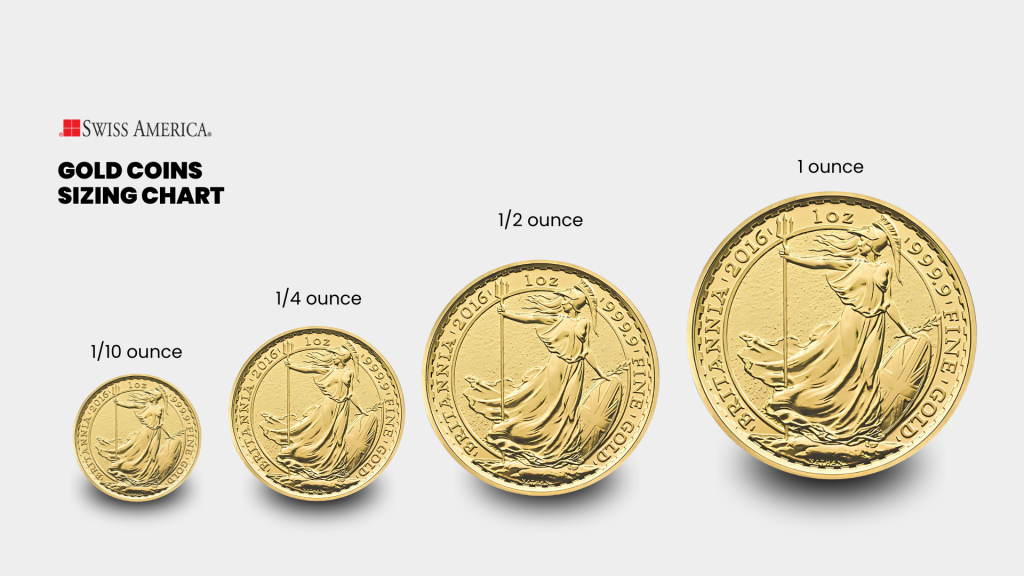
Gold bullion bars
Most gold bars that you buy from a dealer come from manufacturers, although a few government mints also produce them. Bars also come in different sizes.
Sizes: The range here includes eighteen different sizes, but most individual investors buy. The most popular are 1 gram, 5 grams, 10 grams, 20 grams, 1 ounce, 50 grams, 100 grams, or 1 kilogram.
Manufacturers: Common manufacturers are PAMP Suisse, Valcambi, Argor-Heraeus, Credit Suisse, Johnson Matthey, Royal Canadian Mint, Perth Mint, Metalor, Heraeus, Rand Refinery, and Mitsubishi Materials.
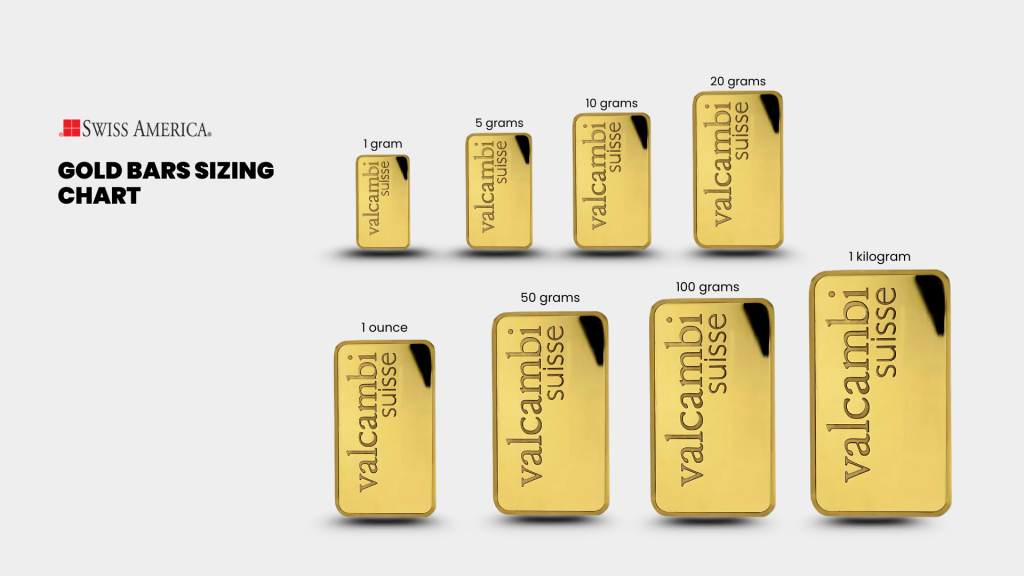
Collectible gold
Collectible coins are also called numismatic coins and have value that goes beyond their gold content. This can include rarity, historical significance, condition, age, and collector demand. Buying gold collectible coins carries more risk than buying gold bullion because their value is more subjective and can move independently of gold prices.
Gold jewelry
And, of course, you can buy gold jewelry. It’s not the same as investing in coins or bars because you’ll pay extra costs for the design and brand that you’re not likely to recover when you sell. When you go to sell it, buyers deduct value for wear and tear or even fashion trends.
Investing in gold paper assets
You can also invest in gold through paper assets. So, in this case, you don’t own the physical gold itself; You own a piece of paper or a part of a company that’s tied to gold. This route includes:
Gold mining companies
If you buy gold mining stocks, you own shares in a company that mines and produces gold. This includes well-known names like Newmont Corporation, Barrick Gold, and Agnico Eagle Mines.
These gold stocks give you exposure to price changes, so you can benefit if the market moves in your favor. But there’s added risk because you’re also relying on the company’s performance, not just the price of gold. That’s a very different scenario from owning the metal itself.
Gold ETFs
Gold exchange-traded funds allow you to buy a share of gold funds that pool resources and hold gold. The value of your investment moves with gold prices, but you’ll pay extra management fees and potentially trading commissions when you buy or sell shares.
Gold mutual funds
These gold funds are similar to ETFs, except that funds might have a basket of stocks like gold companies or gold-related securities. The value of your investment relies on the price of gold and the financial health of the underlying companies.
Gold futures
This is a very risky way to invest in gold. It involves speculating on gold prices and trading contracts to buy or sell gold at a future price amount. You use leverage to borrow against what you think might happen. And yes, you can win big but also lose, so it’s not an investment for beginning investors.
Gold Paper Assets Pros and Cons
| Type of paper asset | Pros | Cons |
| Gold mining companies | Potential for stock price gains if gold prices rise. | Company performance risk, not just tied to gold. |
| Gold ETFs | Easier to buy/sell through brokerage accounts. | Management fees and trading costs reduce gains. |
| Gold mutual funds | Diversified exposure to gold-related companies. | Dependent on both gold prices and company health. |
| Gold futures | High potential returns for experienced traders. | High risk; can lose more than invested with leverage. |
Benefits of physical gold investing
So why do people invest in precious metals or gold? Here are the main reasons and benefits:
Hedge against rising inflation
Gold helps protect your wealth from inflation. When the government prints more money, it weakens the dollar. Over time, that means you need more dollars to buy the same things.
If you own gold coins or bars, you’re buying them with today’s dollars. As inflation rises, the price of gold usually rises too. That increase helps offset the drop in the dollar’s value. In other words, gold tends to hold its worth, while your cash loses buying power.
So, instead of watching your dollars shrink, your gold keeps pace. It’s a way to preserve what you’ve earned.
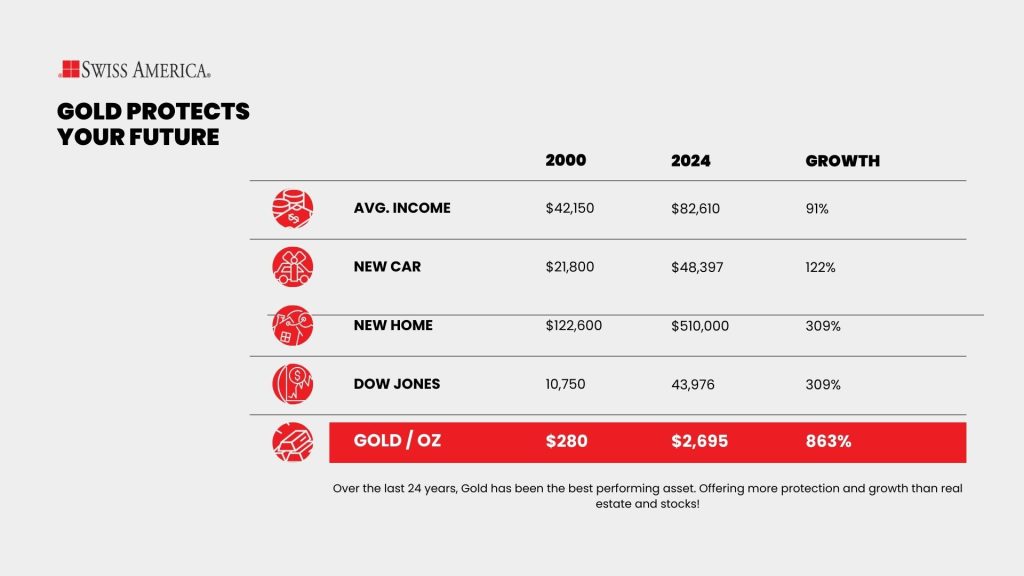
Diversify portfolio
Gold gives you a way to diversify your portfolio. It rarely moves the same way as the stock market, which is the whole point. Instead of having all your assets riding the same wave, you’ve got a piece that reacts differently when things get rough.
Gold pricing usually holds up when there’s a global crisis or economic uncertainty. In many cases, it actually does better.
That’s how it protects your wealth. You’ve carved out a portion of your portfolio that doesn’t fall apart when everything else gets hit.
Tangible asset ownership
When you buy physical gold, you own a real asset. It’s not a piece of paper. It’s not a promise from a company or a bank. You own the actual item.
A lot of people like that. There’s something about holding a real asset that gives you a sense of control.
With gold, that control goes even further. You can take it with you. You can carry it if you need to. You can store it at home. It’s yours, and it’s not tied to anyone else’s system.
No counterparty risk
With gold or any other precious metal, you’re not relying on anyone to hold up their end of a contract. There’s no counterparty risk.
If there’s a financial crisis and your brokerage goes under, you could lose your investments. Or if you’re in a gold ETF and the fund manager doesn’t manage it well, that risk falls on you.
Physical bullion doesn’t come with those risks. You own the gold outright. There’s no need to depend on someone else to follow through.
Risks of physical gold investing
Just like any other investment, there are considerations you should keep in mind when investing in gold. These include:
Price volatility
Gold’s price has increased since the Great Recession, but it’s performed exceptionally well since COVID-19. That doesn’t mean it will always behave that way.
If you look at history, gold has had bull markets even during periods of economic growth. It saw strong runs during the Reagan years and under George H.W. Bush when the economy wasn’t in crisis.
So, while gold can be a great hedge, there’s no guarantee its price will rise. It’s still an investment, and like any investment, it moves in cycles.
Storage costs
When you buy physical gold, you’ll need to figure out how you want to store it. If you’re holding gold outside a retirement account, you have a few choices. You can keep it at home, use a bank’s safe deposit box, or store it with a third-party depository. Each option has its pros and cons, but the key is that you own the asset, so you have flexibility.
If you’re using retirement funds to invest in gold, it works differently. The IRS requires that your gold stays at a third-party depository. Keeping it at home isn’t allowed. If you try, the IRS treats it as a distribution, which can lead to penalties and taxes if you haven’t reached the retirement age of 59 1/2.
No income
Gold doesn’t produce income. You won’t get dividends or any kind of cash flow from it. But that’s not the point of owning gold.
It’s more of a protection strategy. Think of it like insurance for part of your wealth. You’re not buying it to generate returns. You’re buying it to hold value when other things might not.
Still, it’s important to understand that gold isn’t really a money-making investment. It’s a long-term hold meant to preserve, not grow, your wealth.
Creating a gold investment strategy
So when’s the right time to invest in gold? And how should you go about it? More importantly, how do you make the most of this safe haven asset?
Most financial advisors recommend keeping a portion of your portfolio in gold. The exact percentage depends on your goals and risk tolerance, but you’ll often hear numbers in the 10% to 15% range. Gold is a long-term strategy, so it’s not the place for money you’ll need right away. That’s why many people hold it in retirement accounts like a Gold IRA or a Precious Metals IRA.
You’ll also want to rebalance from time to time. If gold’s value rises, it could end up making up a larger chunk of your portfolio than you intended. Keeping an eye on those prices helps you stay aligned with your original strategy. If you’re a Swiss America customer, you can easily track your holdings through our online portal.
We also help investors stay updated on market trends with our weekday blog and regular podcasts.
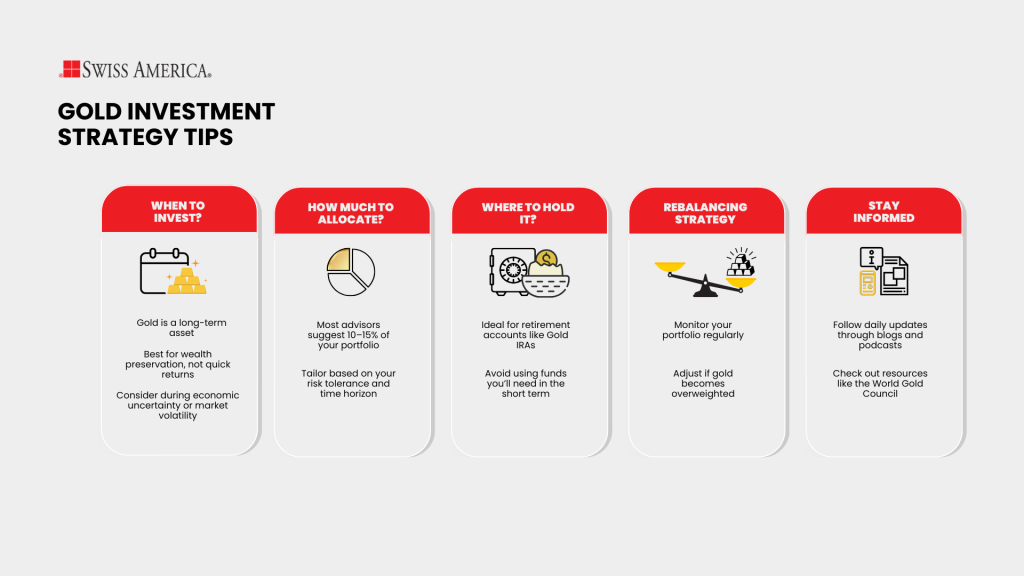
Gold investment mistakes to avoid
Like any investment, gold requires research. If you skip that step, you leave yourself open to mistakes. One of the easiest ways to stay updated is by working with a gold dealer that focuses on education. Swiss America offers a range of tools to help you understand options. For example, if you’re considering using retirement funds, we’ll send you a free Gold IRA kit to help you understand the process.
Consider storage and insurance costs. They’re not overwhelming, but they do matter. If you use a third-party depository, you’ll usually pay around $100 a year for commingled storage that includes insurance. But if you want to store gold at home, you’ll likely need to set up insurance on your own. Either way, those costs can affect your returns over time, so it’s worth factoring them in.
Also, be careful not to go too heavy on gold compared to the rest of your portfolio. You want a mix of assets that can handle different market conditions. As prices change, check-in and rebalance when needed to keep everything aligned with your goals.
Gold investment resources
There’s plenty of great information out there to help you learn more about gold investing. We’ve mentioned some of it throughout this article, but here’s a quick recap:
- World Gold Council:This trade organization shares useful information for gold investors. It publishes market reports, tracks central bank activity, and offers data that helps you understand the gold market.
- Gold dealers: Gold dealers like Swiss America offer more than just the metal. We provide education, research reports, and other resources to help you understand the market before you buy.
- Market news: You can also keep up with market news through major banks like JP Morgan Chase or Goldman Sachs. They often publish in-depth analysis on gold and other commodities, which can give you a broader view of where the market might be heading.
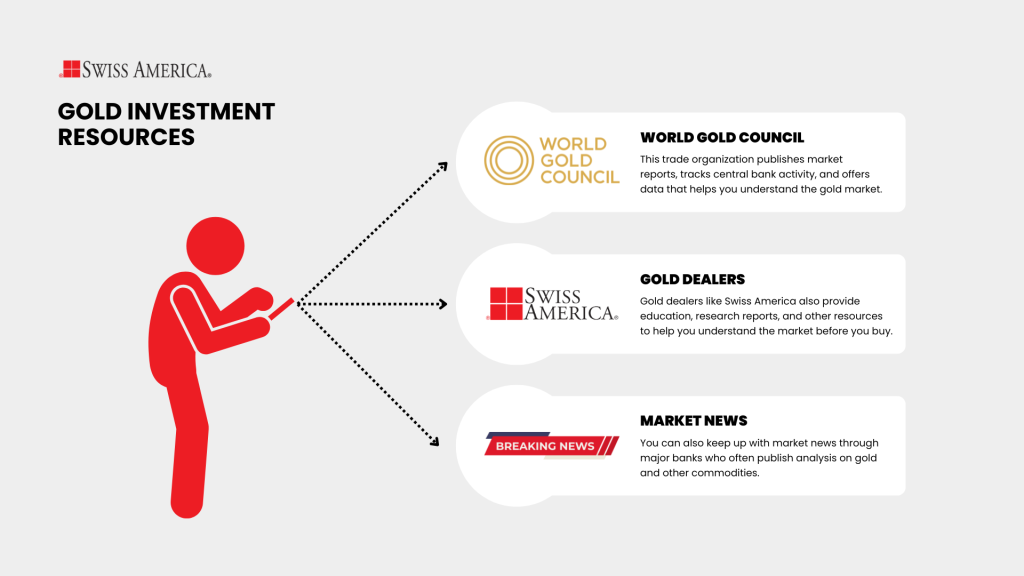
Final thoughts on how to invest in gold
You’ve got options when it comes to gold, but owning the physical metal puts you in the driver’s seat. It’s a way to take direct control of your investment and hold something real. Gold fits well into a broader strategy focused on wealth protection, portfolio balance, and long-term stability.
To learn more about getting started with gold investments, connect with the Swiss America team today!
Investing in gold: FAQs
How do beginners buy gold?
Beginners can start by buying physical gold like coins or bars from a reputable dealer or by investing in paper gold assets through a brokerage account.
Is gold a good investment right now?
Gold can be a smart way to protect your wealth, especially with so much uncertainty in the world right now. No one can say exactly where prices are headed, but many analysts still see reasons for gold to hold its strength or keep climbing.
How much gold can you buy for $1000?
As of this writing, gold’s spot price is about $3,300/oz, which means you can buy several 1-gram or 5-gram gold bars.
The information in this post is for informational purposes only and should not be considered tax or legal advice. Please consult with your own tax professionals before making any decisions or taking action based on this information.
